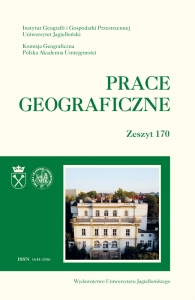Zmiany wilgotności powietrza w Łodzi w latach 1966–2020 w świetle wybranych wskaźników
Changes in air humidity in Łódź in the years 1966–2020 in the light of selected indicators
Author(s): Joanna Wibig, Ewelina KrawczykSubject(s): Environmental Geography
Published by: Wydawnictwo Uniwersytetu Jagiellońskiego
Keywords: water vapour pressure; saturation deficit; relative humidity; linear trend; probability distribution;
Summary/Abstract: The aim of the study is to present changes in air humidity in central Poland in the years 1966–2000 in Łódź as an example. The values of air temperature, relative humidity and atmospheric pressure from four observation terms, 00, 06, 12 and 18 UTC, were used. On this basis, the saturated vapour pressure, the current vapour pressure, and the saturation deficit were calculated. Then, the variability of these three indicators and relative humidity was examined. The variability of monthly and seasonal average values of humidity indices in four observation periods was presented, the trends in seasonal variability of humidity indices were calculated and the distribution functions of their distributions were compared in the midday period in three 15-year periods: 1966–1980, 1986–2000 and 2006–2020. It has been shown that the pressure of saturated water vapour is the highest in summer, the lowest in winter, and slightly higher in spring than in autumn at all times, except for the night. It increased significantly in the studied period as a result of the increase in air temperature. A comparison of the distributions in three 15-year periods shows a significant increase in the probability of occurrence of high values of saturation vapour pressure, even above 30hPa. The water vapour pressure in the air is highest in summer and lowest in winter, but in spring it is lower than in autumn. All trend coefficients are positive, but only less than half are statistically significant. A comparison of the distributions over three 15-year periods show a slight increase in the probability of higher values of the actual vapour pressure. The saturation deficit, as the difference between the previous two indicators, increases significantly. Its value in spring is significantly higher than in autumn. The trend is positive, especially in spring and summer, and the comparison of distributions shows that in the last 15 years the probability of high values of saturation deficit increased significantly. The course of relative humidity is the opposite of saturation deficit. In autumn, the relative humidity is definitely higher than in spring. The trend is down. To sum up, warming brings an increase in the capacity of the atmosphere for water vapour, a slight increase in the amount of water vapour in the air, but also a significant increase in saturation deficit and a decrease in relative humidity, which is particularly strong in spring in the first half of the growing season.
Journal: Prace Geograficzne
- Issue Year: 2023
- Issue No: 170
- Page Range: 119-141
- Page Count: 23
- Language: Polish

